The West Bank LSA Project
The Land Settlement Association ?
[This page is a work in progress and does not represent, as yet, the growing depth of information collected. It will be updated with a clear focus on the history and stories of the local people involved.]
New material will be added in BLUE TYPE!
If you have any further information this would be a good time to send it as the page is about to be reset into a final format.
Photographs Stories Experiences
Where did the people move on to?
If you can help with the development of this project please contact Bill Martin whose details are given below or email this website using FEEDBACK. Another contact point is the Snaith Past and Present Facebook Page.
When "Lock Down" is eased it should be possible for personal contacts to be made so that it is easier to pass on the "stories" of the past.
In 1936 200 unemployed men marched from Jarrow to London in search of work and an end to poverty.
In the same year 1000 unemployed miners and shipbuilders moved to 20 different locations across England, including Snaith in Yorkshire, to begin new lives as market gardeners.
The men from Jarrow returned with nothing.
The tenants on the Snaith LSA became part of a multi-million horticultural industry which still survives today.
Snaith LSA
The story so far . . . . .
Background:
In 2015 Bill Martin created a heritage trail in Sidlesham, near Chichester in West Sussex, to commemorate the LSA which had been established in the village in 1936. A website, exhibitions and a film followed. In 2017 volunteers helped to dismantle an LSA house. It is now in storage at The Weald and Downland Living Museum, awaiting funding to be re-erected. When it is rebuilt the LSA story, including both Sidlesham and Snaith as well as all the 20 LSAs across England, will have a permanent home.
John Lee and Mike Taylor contacted Sidlesham via the website . . . .
Sara Rockcliffe Clerk of PC for both Carlton & Hirst Courtney and who also had a + Family connection..
Paul Arnold, Vice Chair of Snaith & District Historical Society was asked to help...
In 1936, at the time of LSA, Carlton was in the East Riding of Yorkshire (Beverley), re-organisation of government boundaries saw it move first to Humberside and then to the West Riding (Wakefield).
The Snaith LSA story (below) is work in progress and there are lots of gaps.
Can you add more pieces to the LSA jigsaw with the names, dates and stories of former tenants and staff?
Many thanks for your help.
Bill Martin
07931 363 573
Introduction
The Land Settlement Association (LSA) was a UK Government scheme set up in 1934 to re-settle unemployed workers from depressed industrial areas, particularly from North-East England and Wales. Between 1934 and 1939 1,100 small-holdings were established within 21 settlements across England.
Abbotts Ann (Andover, Hampshire)
Broadwath (Cumbria/Carlisle)
Chawston (Wyboston, Bedfordshire)
Crofton (Cumbria/Carlisle)
Dalston (Cumbria/Carlisle)
Denham (Suffolk)
Elmsthorpe (Leicester)
Fen Drayton (St. Ives, Cambridgeshire)
Foxash (Colchester, Essex)
Harrowby (Lincolnshire)
Low Fulney (Lincolnshire)
Newbourn (Felixstowe, Suffolk)
Newent (Gloucester)
Oxcroft (Bolsover, Derbyshire)
Potten (Bedfordshire) 1st one
Sidlesham (W. Sussex)
Snaith (Yorkshire)
The Abingtons (Cambridge)
Yeldham (Essex/Suffolk)
+ Boverton (Glamorgan)
Stannington (Sheffield)
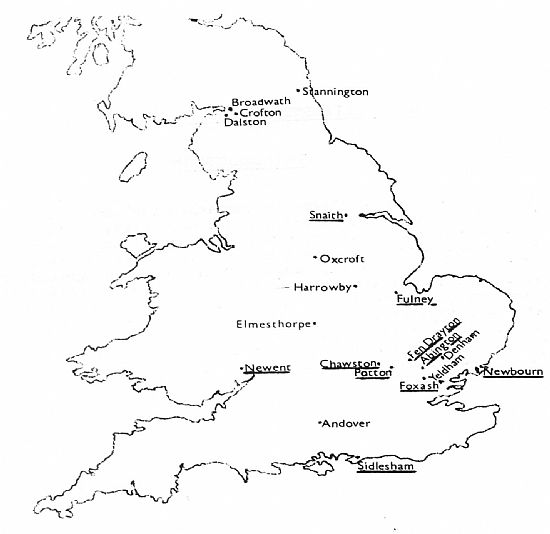
This map (above) is taken from ‘The Land Settlement Association’ by K.J. McCready (1974).
LSAs were set up in rural areas where each successful applicant’s family would be given a small-holding of approximately 5 acres, livestock and a newly built house. Small-holdings were grouped in communities which were expected to run agricultural production as cooperative market gardens, with materials bought and produce sold exclusively through the Association. All applicants were interviewed and given agricultural training before being assigned a property.
The allocation of smallholdings to the unemployed was suspended at the outbreak of the Second World War through the necessity of increasing food production; favour was then given to those already with horticultural skills. After the war the Association was incorporated within the 1947 Agricultural Act for statutory provision of smallholdings designed as a first step for those going into agricultural production. The scheme was wound-up and all the properties privatised in 1983, by which time it was producing roughly 40% of English home grown salad crops. The residual assets of the scheme were constituted as the LSA Charitable Trust, for the benefit of former tenants and to promote horticultural education.
Snaith LSA
Original purchase – West Bank Hall - Farm & 300 acres of land? (MERL)
Charles Weddell – local squire sold farm to LSA (Mike Taylor)
A film ‘Here is the Land’ (1937) was shown in Dole Offices to recruit people to the LSA. A copy can be seen on You Tube:
https://www.youtube.com/watch?v=cAQwZarA58c&t=7s
Article in Cumberland News - ‘Farming experiment sows the seeds of success’ Past and Present by Denis Perriam(cc 1990)
“The Land Settlement Association was a scheme, organised along co-operative lines, as an experiment to provide work for the long-term unemployed from Special Areas set up in the depression. Various organisations, concerned with the welfare of the unemployed, had met in 1933 and had agreed to jointly fund the scheme, providing the government would match the money from voluntary sources. It was agreed that the government would provide £50,000 from their special areas fund and a further £75,000 after that period. The Land Settlement Association was incorporated under the Industrial and Provident Societies Act in November 1934, known by its initials, LSA.
Most of the LSA estates were south of the Humber; there was only one in Northumberland, but Cumberland had three and one at Snaith.
The LSA carefully chose their estates because they required good agricultural land, but in acquiring it they would not put anyone out of work. The objectives of the LSA were given in publicity materials distributed throughout the Northumberland Special Area, where there were many out of work miners. Miners were at first sceptical of the scheme, in which the ‘unemployed could be successfully re-established in life as self-supporting smallholders,’ when few of them had any experience in this type of work.
Each man was provided with a house for his family, a greenhouse, garden, hen houses and a piggery, depending on their preference. Holdings varied between 4 and 11 acres, but each smallholder had to pay a rent and comply with LSA rules. Seeds, plants, tools and livestock had to be purchased from the LSA and all sales were through the association. Here was a centralised packing station and transport was arranged to take the produce to market.
A National Association of Tenants had local representation. Estates could equal a small village of between 200 and 400 people, including families, and Snaith had a total of 40 holdings. The LSA provided all of the facilities needed for running each estate, including the social needs.
Everything was to change with the war. There was then full employment, as anyone out of work was expected to work. Training for tenants ceased and recruits came from the farming community. Only those who had the experience and the necessary capital to start a smallholdings were allowed as tenants. Special loans were arranged for those who couldn’t find the capital.
Responsibility for the scheme passed from the Commissioner for Special Areas to the Ministry of Labour, under the wartime food production programme.
Once the war was over, the Government looked again at the scheme. Under the Education Act of 1947, the LSA was to run the estates on behalf of the Ministry of Agriculture. The LSA was no longer an experiment, but something that worked and was successful, even if it no longer fulfilled the reasons for which it was set up.
In the aftermath of the Brown Committee Report on the LSA in 1960, the agricultural correspondent for the Cumberland News criticised the LSA which he thought needed to be completely overhauled.
“Tenants”, he said, “were given the feeling that they were not working for themselves, but for the benefit of the Government. Whitehall was too autocratic and there were few facilities for tenants to air grievances, except at estate level. Formerly tenants depended on the LSA for technical advice, but the present tenants are mostly men who have made a success as agricultural workers and have saved to enable them to branch out on their own. They are more individualistic and are able to manage without the LSA.” He felt that the tenants could purchase their seeds and stock much cheaper outside the LSA and sell at a more favourable price.
……………………………………………………………………………………………………………
Enquiries are invited by The Lane Settlement Association Ltd from agricultural and horticultural workers wishing to make a start on their own. Holdings are available on several of the association’s 18 estates and Estate Managers are now interviewing prospective applicants.
These holdings are family holdings, with modern houses, averaging 5-10 acres. They are fully stocked and equipped for horticulture under glass and in the open, and for pig and poultry keeping.
Applicants must have been full-time wage earners in agriculture or horticulture for at least 5 years and should have £500 to £600 to invest.

The Association, which administers these holdings for the Minister of Agriculture, has facilities for arranging loans up to 75% of the total capital requirements.
For application form and illustrated folder write to: The General Manager (Ref. G/1958/1) 43 Cromwell Road, London SW7
(The Grower, November 1958)
Professor Wise was appointed by the Government in 1963 to report on the LSA. His findings published in 1967, recommended that the number of LSAs be reduced to 10. Snaith LSA continued for another 15 years, until the closure of all remaining LSAs was announced in the House of Commons on 22nd December 1982. Tenants had the right to buy their houses and smallholdings and LSAs were encouraged to continue as independent companies.
Most of these former LSA independent companies have now ceased trading. However,
Snaith Salad Growers, a subsidiary of Yorkshire Salads, is still operational (2021).
Yorkshire Salads/Snaith Salad Growers Ltd website:
“Snaith Salad Growers Ltd is a growers Co-operative which was formed in 1983 following the closure of the former Land Settlement Association. Based at West Bank, Carlton in the East Riding of Yorkshire the organisation, who’s roots are firmly based in the East Riding, is actually now made up of 6 members spread across England”.
In 1984, after the closure, a group of LSA tenants (cc 290) from LSAs across the country put in a claim for compensation, through their National Tenants Association, against the government. In 1991 the claim was settled in favour of the tenants.
Snaith LSA: Smallholdings and other property:
The first tenants lived in ssssss (community hut?) or West Bank House??? while they were being trained and when their houses were built they were joined by their families.
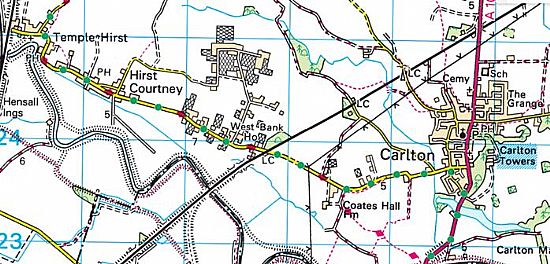
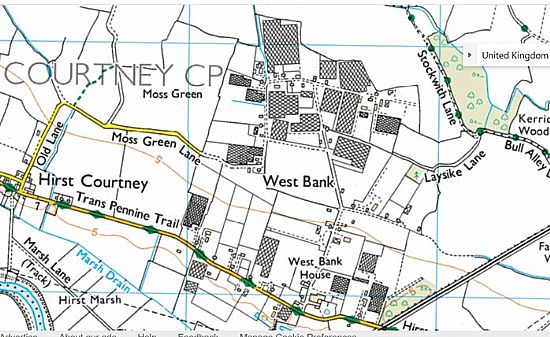
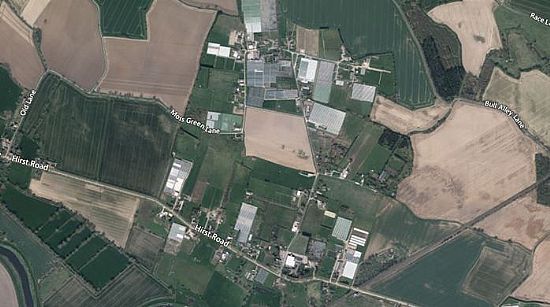
cc 1950
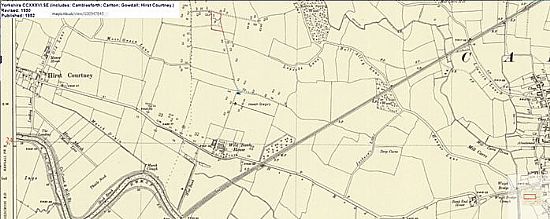
Snaith LSA had 38 (?) properties, numbered sequentially (1-38). zz smallholdings and vv staff houses as well as a number of tied cottages from the former West Bank Farm? (eg Duffin Wood Gatehouse & West Bank Cottages are listed on the 1939 Census?) which housed LSA staff?
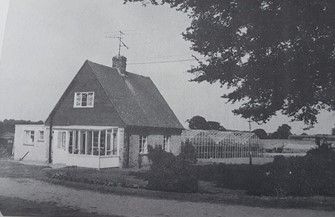
A typical LSA house from McCready page 72
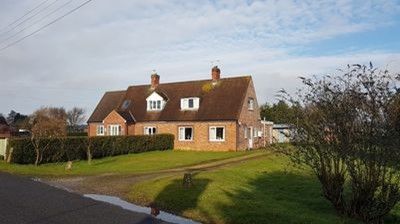
Photo from Kevin Archer
Road names 1-38 (all on West Bank?)_
Anne Laws (No 2) West Bank, Hirst Road is a possible Stirland home build.
If so, the houses may have been constructed by Stirland, a building company still based from Birdham in West Sussex – they also had the contract to Sidlesham and Newent LSAs) Cost £325single, £650 double
Were the houses, as with other LSAs built for the LSA’s first tenants or, as has been suggested already there? Parish Clerk (Sara) thinks they may have been set up for soldiers returning from the first world war rather than unemployed miners and shipbuilders of the 1930s ?
How many were Single, semi-detached
The LSA HQ was based at West Bank Farm with
- A Packing Shed where produce was graded and packed.
The manager in 1960s was Albert Ounsley and one of the staff called Lily who used to cycle 10 miles to work every day. (Pam Sparkes)
- Offices, where tenants’ accounts were ‘maintained’ and marketing took place, were part of West Bank House (Manager’s house, Offices and The Flat)
- The Stores where tenants could purchase equipment , fertilizer and feed for animals.
- A Propagation Unit with a glasshouse, located adjacent to the packing shed, produced seedlings for the smallholders.
- There was also a joiner’s shop. Other LSA’s had a Maintenance Unit, comprising carpenter and plumbers, for the upkeep of LSA houses and glasshouses
- The Stack Yard was for the tractors, trailers, ploughs and various implements including a large coal-fired steamer for sterilising the greenhouses.
West Bank House, on the same site, became the home of the LSA Manager, appointed by the government.
John Cox - manager (1959-64)
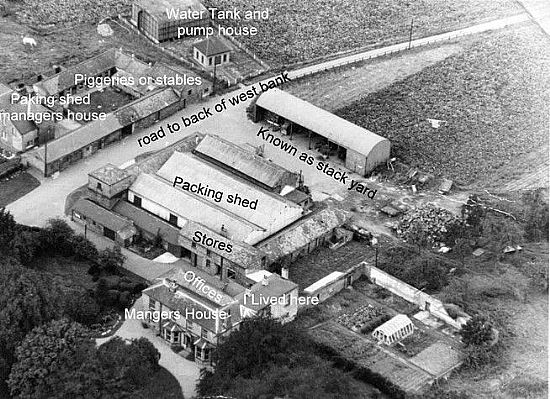
West Bank House
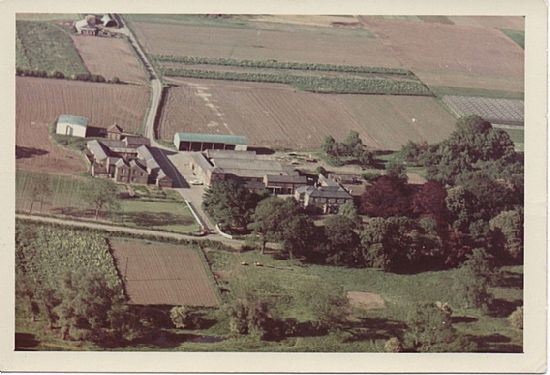
LSA staff cc 1960
Back Row: ?, Mr Ormisher (accountant), Mr Hamlett, Gordon Smales, Mr Rollinson, Peter Leighton, Albert Neale, Ron Huby (in beret, Mr Pepper, Maurice Richardson, Bob Leighton, Norman Hinsley, Mr Sidey, Reg Smales, Mr Reed
Middle: Lily Buckle, Albert Hounsley, (Paddy) Jim (Irish), Sid Derry, Chris Sheridan & Wendy Smith (Question marks indicate summer relief staff who worked in the packing shed.
Front: Kath Whitaker, Barbara Smith, Elsie South, Betty Potter, Joyce Richardson, Julie Turton, Joan Richards, Hetty ?
Barry Tyndall's brother, John has provided new information.His sister-in-law, Margaret Pacey [Nee Laycock] who used to work in the offices. Neither Margaret nor her husband Tom Pacey, who used to drive a lorry or tractor at the time are shown on the photograph.
Anymore photographs out there? Please send them to the website!
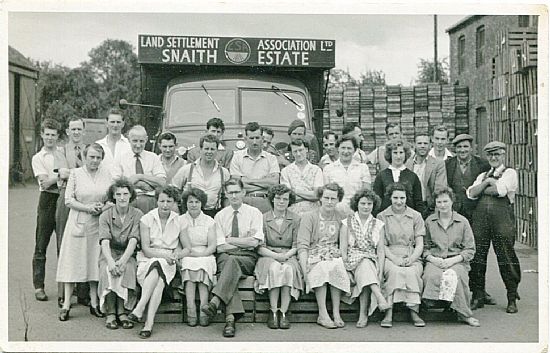
Props
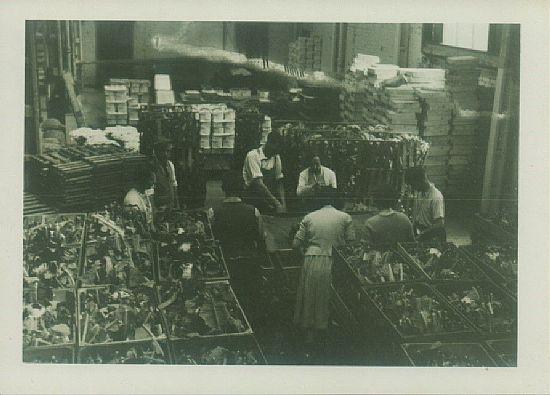
P. Shed cauliflowers
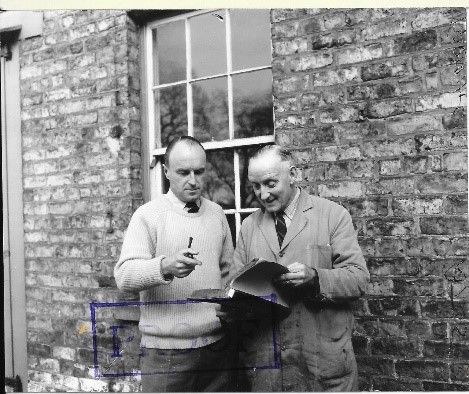
John Cox manager (1959-64) and Albert Ounsley P.Shed manager
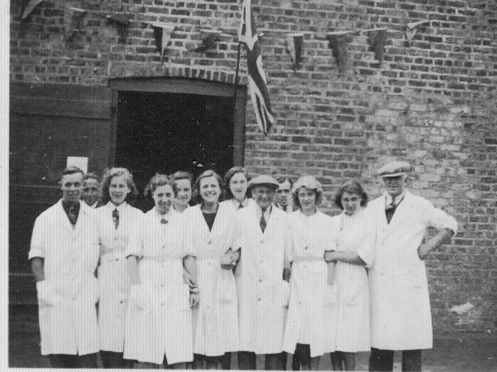
P. Shed staff VE day flags
Andrea Barker/facebook – Mr Young was in charge of the prop , at that time they sent all plants out to the holdings. It was a large greenhouse area behind the packing sheds. The big house there is where the manager lived at that time a Mr Day, he I believe was the manager for this area LSA I think. Andrea Barker
My first summer job at the prop with Mr Young and another man can't remember his name. Another couple of summers in the sheds packing tomatoes, few of us we loved it, to mention two. Then Steve Brankleys and Ian Clough.
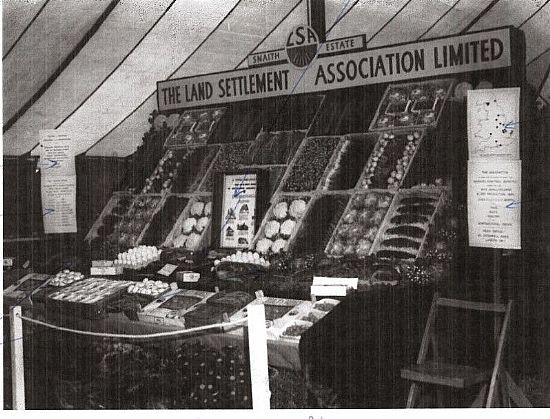
A community hut where the first tenants lived while they were being trained was situated near Gregory No 14 Location ???? Once their houses were built their families joined them and the hut became a community centre for the LSA. (Martin Huby) The Social Hut quite a large community hut it was used for many things including Sunday School, and a youth club, now been demolished.
The children of LSA tenants went to Hirst Courtney School. In the early days children would have left school at 14 years of age. The school leaving age rose to 15 in 1944 and to 16 in 1972. The School Admissions Register at that time listed those children who came with their families from the NE of England, giving in some cases the names of their previous schools and thereby the town from which they came. The school at Hirst Courtney is now closed, but its Schools Admissions Register could be the North Yorkshire County Records office at Northallerton ?????
During the war when a number of evacuees came to the village four class had to be accommodated in the three rooms.
The headteacher of the school from 1942 until 1967 was Alfred Taylor (see story below)
The family (Wife, Ida and son, Michael) lived in the Schoolhouse, adjacent to the school.
Viv Hutchinson was at the school during the 1960s (See story below)
[In the information given below ER refers to details taken from the Register of Electors]
Snaith LSA: Smallholdings, Tenants and staff: (Total 112)
???? Robertson (Scottish family in NE corner of the estate.
???? Joyce Punton (facebook)
West Bank Hall: Managers
1939 (June) Hartles (in The Times’ article – could have been regional LSA representative?)
1939 Census (September) Percy & Marjorie Brown - Estate Manager for the LSA.
1951 ????? Herbert & Kathleen Eyrl (Polling List 1951)
1950s (ER) Lancelot & Sybil Duncan
1950s (ER) Phillip & Dorothy Hamlett
1959-64 Arthur & Gertrude Cox - then moved to Sidlesham LSA as Manager. (See story below)
Pam Sparkes email
1960s E,J.O. Day Andrea Barker/facebook
The Flat (part of West Bank House)
1957-70 Ronald & Pauline Huby - tractor driver, then Storekeeper.
I remember the 2nd holding just over the level crossing used to belong to a family named McAuley. (I hope I’ve spelt their name correctly.) Ivan Tasker?facebook
West Bank Farm Cottages:
1939 Census Oliver & Minnie Dean – Technical Adviser + Peter & Ann Luck (Horseman on farm)
1940s (ER) Frederick & Edna Wade
1950s ????
1960s (ER) John & Joyce Oliver
Duffin Wood Gatehouse ?????
1939 Census: Robert & Dora Leighton – General Labourer Public Works (LSA Maintenance Team?)
West Bank Farm:
1940s (ER) James & Lily Brown
West Bank House:
1951 Frederick Dougall (Polling List 1951)
West Bank Holding (?)
1939 Census - George & Lilian Firby - Horticultural Supervisor
West Bank:
Properties on the front road
No 1:
1939 Census: Robert & Edna Purdy General labourer + 6 children & named in The Times article meeting the Duke of York (See Story below)
1950s (ER) Newton
1960s (ER) Alan & Annie MacCaulay + Harry
19?? Hinsley first names?? (from Martin Huby)
No 2:
1937
1939 Census: Arnold Von Beverson - Market Gardener.
1940s Tom & Dorothy Atkinson
Kept the obligatory pig and grew lettuces. 6d a box .
After, then farming at High Eggborough .
No 2 house at West Bank Hirst Road is a possible Stirland home build.
Ann Laws aelb.lib@gmail.com
1950s (ER) George & Marjorie Towse George Towse. George left in the mid ‘60’s and he and his wife took over the running of the Sloop Inn between Hirst Courtney and Temple Hirst (where, incidentally, there was a railway station until about 1960).
1960s (ER) John Atkinson
No 3:
1937 (ER) Lionel & Caroline Robinson with Thomas & Lily Tyreman
1939 Census: Thomas & Lily Tyreman – Market Gardener + 1940s
1950s (ER) James & Ivy Atkinson They had a son John, who took over Holding No.12, and a younger son.
No 4:
1939 Census: Christopher & Caroline Clark – Market Gardener + 1940s
1950s/60s (ER) Joseph & Gladys Foster
Early 1960 Arthur Atkinson. [his son,John Atkinson, took the first property coming from the direction of Hirst Courtney several years later]
1970s???
1980s (ER) Dave & Mary Parkinson
No 5:
1939 Census: No entry
1945 (ER) Thomas & Elizabeth Trench (June 1945 Civilian Citizens Register)
1960's Fred Chilton and Mrs Chilton and grown up son John
? (via Martin H)
No 6:
1939 Census: No entry
1940s (ER) Tom & Olive Heslop
1960's Tom Wildon, his wife and five children (Ann, Colin, Stephen, Michael and a little girl).
No 7:1939 Census: No entry
Tindalls took over from Mr and Mrs Bill Talbot who had one daughter called Barbara. [Barbara is believed to be a friend of Jane Barrett who lived at the back of the estate.]
Three delivery vehicles used to provide food provisions to the estate - Mr Moss from Carlton - he had seen action as a rear gunner in the war, F.D & W Shaw from Snaith - Mr Shaw had a tall, rickety van which you could enter into and Butcher Baxter from Carlton who carried his meat round in a grey Bedford van.
from 8th December 1960-1971
William & Phyllis Tindall. Three sons, John, Barry and Stephen.
No 8:
1939 Census: No entry
1940s Joseph and Phyllis Midgley (June 1945 Civilian Citizens Register)
1940s (ER) Ernest & Grace Hales
Carl Gawtry (Facebook) I worked at West Bank first as teenager weekend job from 1960 then did my apprenticeship at no 8 from 1972 to1976
1970s (ER) Henry Blackburn Henry and Kathleen Blackburn. They had one son called Raymond.
No 9:
1939 Census: No entry
1940s (ER) Reginald & Dora Wrench
1962 onwards Norman Taylor and his wife.
No 10:
1939 Census: No entry
1945 (ER) Lavinia Emms/Freda Ewing (June 1945 Civilian Citizens Register)
1960's This holding was unoccupied for years.
No 11:
1939 Census: No entry
1960's Tom & Mabel Willis.
No 12:
1939 Census: No entry
1945 (ER) Charles & Agnes Lose (June 1945 Civilian Citizens Register) Close ????
No 12A (when built????
1930s (ER) Stanley & Marion Wilson
1960s John and Margaret Atkinson.
Barry Tindall writes
I knew many of the tenants from the holdings going past the packing shed but cannot with any accuracy provide the holding numbers.
Names I remember :-
Lionel Seymour, Mr and Mrs Mells and their son Geoff, Walter Weston – he had two sons, one of whom was called Chris, and I believe both took on holdings, Bill and Dorothy Terry (I think No.22) who had two daughters, one of whom was called Sue, Henry Barratt – three daughters, Ruth, Jane and Ann. Bill Temple (No. 35 or No. 36), Mr & Mrs Close and a son David.
I remember Mrs Dowd who was the assistant to Mr Ormisher in the office.
I recall that Packing Shed Manager, Albert Ounsley, was replaced by Bill Turvey who had 2 sons, Frank and John.
I also recall the arrival of Mr. Robilliard in the Prop. I think he was from Jersey and spoke Breton French as a first language.
No 13:
1939 Census: Christian & Elizabeth Young – Plumbers labourer (LSA Maintenance Team ?)
1950s (ER) Richard & Margaret Dyson
1960s (ER) George & Lucy Langrick
No 14:
1939 Census: Joseph & Mahaler Gregory + 7 children – Market Gardener + 1940s/50s See story below
1960s (ER) Robert & Jean Cooper
No 15:
1937 (ER) Thomas & Maud Green
1939 Census: Thomas & Florence Harrison – Market Gardener + James (retired) + 1940s
1950s/60s (ER) Harry & Florence Tasker
No 16:
1937 (ER) William & Mary Richardson
1939 Census: Robert & Dorothy Johnson Foreman Public Works (LSA Maintenance Team?)
1940s (ER) William & Mildred Lancaster
1950s (ER) Donald & Alice Glaze
No 17:
1939 Census: James & Lily Brown – Market Gardener +1940s
1940s (ER) Frederick & Thomas Dunn
1950s (ER) Charles & Violet Botterill
1960s (ER) Paul & Maria Cross
I know grandma did a lot round West Bank didn’t she xx Katie Cuckoo yes she worked for Mr. And Mrs Cross. When Mr. Cross died she continued to work with Maria his wife. I remember a van collected workers from Snaith daily to work in the Greenhouses. As a youngster I spent all school holidays roaming around West Bank having a great time. Sue Ryder
No 18:
1937 (ER) Phillip & Mary Sutton
1939 Census: Samuel & Esther Goodswin – General Labourer Public Works (LSA Maintenance Team?)
1940s (ER) Eva & George Clark
1940s (ER) William Robinson
1950s/60s (ER) Arthur & Eva Daley
No 19:
1939 Census: William & Jane Harding – Market Gardener + 1940s
1950s ????
1960s Henry & Dorothy Mells
No 20:
1938 Mr W. Reed (Tenancy Agreement 28th October 1938)
1939 Census: James & Frances Reed – Market Gardener + 1940s
1950s (ER) Francis & Margaret Reed + James
1962-70 Richard Anthony Wharton (Dick or Tony) + Brenda Wharton (nee Rogers)
No 21:
1939 Census: No entry
1930s (ER) Thomas & Lily Tyreman (See No 3 ???)
1940s (ER) Norman Leetham
1940s (ER) Wilfred Hemmingway
1950s (ER) John & Jane Harding (See No 19 ???) + William Harding
1960s (ER) Jane & Leslie Harding + William Harding
I recall you entered from the road from Carlton to Hirst Courtney and it went round in a crescent. My Grandad, Bill Harding lived on the right just before the road went round to the left. I can’t remember the no. I dont think I ever knew it. I remember cycling down the road picking apples from the trees on the side of the road and dropping them in my basket. Such fond memories of that place. It was where I got struck by lightening for the first time too! Pam Edwards Noticed in 1937 and 1938 your Grandad Arthur and Grandma Rebecca lived at number 35 West Bank then moved to No 37 in 1938. Geoffrey Cooper
No 22:
1937 (ER) James & Mary Henderson
1939 Census: No entry.
1940s (ER) Roy & Gladys Bradbury
1950s/60s (ER) William & Dorothy Terry
1970s Mr Boynton
Late 1970s Bert and Janette Wilson with children Ian and Claire
No 23:
1939 Census: Joseph & Elizabeth Sowerby – Market Gardener + 1940s
1950s/60s (ER) Alan & Annie Stapleton
1973 – present time (2021) Paul & Denise Weston (Denise/facebook)
No 24:
1939 Census: Ernest & Hannah Gray – Market Gardener
1940s (ER) John & Hilda Graham 1940s
1940s/50s (ER) Lawrence & Margery Dow - emigrated to Australia
1951-60s (ER) Walter & Sally Weston with their sons Christopher and Paul Weston.
No 25:
1939 Census: Albert & Ada Dougall – Market Gardener + 1940s/50s
1950s Kate Rosbrook
1960s Tom Ruston and his wife.
No 26:
1939 Census: Thomas & Grace Grundy – Market Gardener + 1940s/50s
1960s (ER) Joseph & Ada Miller
1970s ????
1980s (ER) Pete & Jean Hardwick (+ via Michaela Williamson (facebook)
No 27: (Detached)
1939 Census: William & Jane Reeves + 5 children – Market Gardener
1940s (ER) William & Elizabeth Edwards
1951-60s (ER) Lancelot & Sybil Thomas + Evelyn Lamplough
19?? Speck ??? via Andrea Barker facebook
19?? Ian Clough ??? via Andrea Barker facebook
1976-1993 & Zena Boasman + smallholding at No 22. Contact ????
No 28:
1939 Census: Stanley & Marion Wilson – Tractor/Lorry Driver
1940s (ER) George & Dora Orum
1950/60s (ER) Gordon & Jean Gregory (son of No 14) 1979 (Erica Gleissner worked there/facebook)
1970 (ER) Gordon Gregory
Brent (son/Arizona) – Viv (Hutchinson (daughter? On facebook) see story below
No 29:
1939 Census: George & Sallie Lowes – Market Gardener
1940s (ER) Ernest & Edith Harris
1950s (ER) ?????? Stanley & Joan Holmes
1949-58 Beryl Sykes – parents name’s ? see below
I lived at 29 West Bank from 1949 to 1958 it was the real good life pigs chickens greenhouse which grew tomatoes in summer and forced rhubarb in winter. Lots of strips of outside veg and structure with lettuce. We continue to grow similar crops on our present county council holding and loved every minute!
No 30:
1939 Census: George & Beatrice Lloyd – Market Gardener + Elizabeth Chapman (ER)
1950-61 (ER) Cyril & Maria Atkinson + Mary (See story below)
Mary Fleischman I grew up on West Bank and then at Carlton and there are so many familiar names on there.
No 31:
1937 (ER) Alfred & Edith Skaifs + Edith
1939 Census: Thomas & Margaret Mahon – Market Gardener
1940s ????
1950s ????
1960s Ronald & Beatrice Lawton
No 32:
1939 Census – no name
1940s (ER) John & Sarah Jones
1940s (ER) George & Florence Gillingwater
Pam Edwards I believe he did take part in the March. Must be where my political leanings emanate. West Bank has changed so much Pam. All the houses are now private and still run as smallholdings. I sometimes go for a ride round. My grandads shed is still there where we used to sort the produce out. I remember your grandparents, the Hardings very well.
No 33:
Not on 1939 Census
1940s (ER) Eric & Vera Newton
1950s Jack Routh and his wife.
No 34:
Not on 1939 Census
1940s (ER) George & Marjorie Savill
1950s Sylvester Family (Children Philip b. 1945 and elder sister Penny)
1980's Ken and Janet Wells (Children Simon & Clare)
No 35:
Not on 1939 Census
1940s (ER) George & Ester Shafto
No 36/37:
No 36:
Not on 1939 Census
1940s (ER) Edward & Dorothy Hewitt
No 37:
Not on 1939 Census
1940s (ER) Arthur & Rebecca Colby
My grandparents from Jarrow were some of the earliest settlers at West Bank. Most of the early settlers were from the North East following the decline of the Tyne Yard shipyard Chris Arnold Facebook/Snaith
I believe he did take part in the March. Must be where my political leanings emanate. West Bank has changed so much Pam. All the houses are now private and still tun as smallholdings. I sometimes go for a ride round. My grandads shed is still there where we used to sort the produce out.
No 38:
1950s (ER) Roy & Alma Hudson
vvvvvvvvvvvvvvvvvvvvvvvvvvvvvvvvvvvvvvvvvvvvvvvvvvvvvvvvvvvvvvvvvvvvvvvvvvvvvvvvvvvv
Snaith LSA: Stories: (9) Clerk of Carlton PC, School (2), West Bank Hall + Nos 12, 14, 30 & 63
Carlton Parish:
I know quite a bit about the Snaith LSA because my husband's aunt and her late husband have had one of the holdings from 1960, their sons still have it today and they sell the lettuce that they grow through Snaith Salads. Coincidentally, I am also the Parish Council Clerk for Hirst Courtney & West Bank Parish Council and I think it would be best if I asked them who would be the best person for you to contact about the local history of the LSA. They are meeting on Monday evening so I will let you know more next week.
Sara Rockcliffe (Clerk, Carlton & Hirst Courtney PCs)
Hirst Courtney Prinary School:
My father (Alfred John Taylor) was headmaster of the Primary School in Hirst Courtney, the next village to West Bank; his school served the children from the LSA. We moved there in 1942 and he was head for 25 years and so he knew everyone in the area. I went off to university in 1952 when I was 18 and then took a job in Luton and so I would not know John Cox but I would enjoy contacting Pam Sparkes who would know my mother and father and perhaps my younger sister. I still have old friends in the area and in fact one of them has written a history of Hirst and adjacent villages but not including West Bank but his booklet mentions Charles Weddall who was the local `squire` who owned West Bank farm which he sold to the LSA. The book contains a picture of West Bank House. I visit the area very occasionally when I go to school reunions (my secondary school) and so I know about Yorkshire Salads and I drove around the old LSA estate just a few years ago. The LSA provided me with some of my pocket money when I was in my early teens because I would pick soft fruit and peas there.
Mike Taylor (Son)
+
I went to Snaith primary school in the mid-60s Vivien Gregory was my name, I remember being in the outdoor classroom at the end with a teacher who loved Cliff Richard's, she would often play Bachelor boy to us and she had really good hearing as she would rush us all outside to see Geese flying in a v formation above. She could hear them coming way before you could see them. What was her name? Kathleen Hoe was my best friend in those days and Miss Poskitt was the headmistress, I am surprised to see how young she is in the photos, as a child you think of her as being old.
Before school I used to pick lettuces on my uncles holding we once broke the record for lettuce picking! Making up the cardboard boxes from the flat packs meant you got loads of paper cuts. Back home at about 7.30 to get on the school bus. (Viv Hutchinson, nee Gregory No 28 ???)
+
In 1941 I started at the village school two miles away, riding there on a seat on my father’s bike, then cycling alone from the age of 7 on a little red two-wheeler re-incarnated from somebody’s attic by my uncle.
We had to carry gas masks in little cardboard boxes strung around our necks wherever we went in case of enemy gas attacks. At home our windows had had to be covered at night with blackout curtains so that no chinks of light could show to help enemy planes. We dreaded the opprobrium of the Air raid Warden shouting “Put that light out”. At school the windows were covered with a stick-on paper mesh to reduce the risk of slinters in case of bombing and fire buckets filled with sand and water stood in the corridor.
Paper was very scarce and so were pencils and just about everything else. The paper in our exercise books was made from wood waste. It was grey and nubbly, with tiny wood-chips that made holes if you pressed too hard. The pencils were poor to; the leads broke very easily on that nubbly paper and the wood was rough and splintery with no polish or colour A rubber was a rare treasure, so we had to get things right first time! Every minute space in one’s exercise book must be used up. I still feel guilty if I wrote double-spaced!
Extracts from ‘Wartime memories of a Country Child’ by Valerie Moore (nee Lose)
West Bank Hall: (Cox)
I remember our time at Snaith very well. My father was LSA Manager there from 1959 to 1964. As you suggest I always knew it as Carlton. I remember the packing station , which seemed to be run by one Albert Ounsley and one of the staff called Lily who used to cycle 10 miles to work every day. My memories of Carlton are very happy ones and I know how sorry we were to leave – more to follow.
Pam Sparkes (Daughter)
No 12: Lose
During the war I lived with my parents on a market garden at West Bank (No 12). It had been a very quiet and remote area, but soon that began to change.
Although I was only three and a half I can remember the atmosphere of fear and anxiety that overwhelmed those late summer days. Adults conferred tensely in quiet huddles with neighbours and we cycled to chapel more regularly in order to feel less isolated and to pray in company.
On that historic Sunday my parents were invited to the house of friends after Chapel to hear the declaration of War speech on the radio. They all listened in appalled silence, while I stood looking at a tuy tin fort with lead soldiers in it, wondering what war was going to mean to us. I soon discovered that one thing it meant was that most of the younger men we knew went off to join the Forces. This did not include my father, partly because he had very poor eyesight and partly because his job as an essential food producer was a ‘reserved occupation’ like that of my coal-mining uncles in County Durham. So we were lucky enough to have our own fruit, vegetables, eggs, chickens, pigs, rabbits, geese, goats and bees.
The ‘phoney war’ of late 1939-40 was a strange time – lots of planning and organising going on, but no real activity as far as we could see. Then the Battle of Britain in the air began. The flat fields of the Vale of York were well placed strategically for air access to the industrial heart of Germany and soon we were surrounded by three or four airfields of Bomber Command and we heard the sound of planes day and night, first training and then going on real raids, droning away through the evening sky.
I thought that our Air raid Warden was a very important man, almost equal to Mr Churchill, as he rode up and down the lanes on his bicycle, ringing the commandeered school hand bell when raids were expected, then doing it all again for the ‘All Clear’. My father was honoured by being given the custody of an ARP stirrup pump, in order to fight any incendiary fires at our end of the village, but luckily he never had to use it. It did, however, come in handy to quench the last embers of our Victory Day bonfire in1945.
My father joined the Home Guard, here he was rapidly removed from rifle training after shooting the target of the next man in line, and narrowly missing the sergeant! He was relegated to the cookhouse, and from a man being famed for his inability to make tea or boil an egg, he became proudly responsible for feeding 30 or 40 men.
Occasionally we saw dog-fights in the sky between feeding Spitfires and marauding German fighters. A train and a bus in a local village were machine-gunned, luckily without injuries, and sometimes we heard the distant ‘crump’ of bombs falling on Doncaster or Goole and saw the faraway glow of fires and searchlights in the night sky. A stray bomber dropped three bombs in fields nearby and everyone cycled over to see the craters. The big boys searched for shrapnel souvenirs until the Air raid warden saw them off. A home coming RAF bomber crash-landed at the edge of our nearest airfield, Burn, missing a row of cottages by inches. We cycled over to see it, that was the nearest we ever got to a wartime plane.
One day some cycling planes dropped thousands of half-inch wide strips of tinfoil around the countryside. We couldn’t find anyone who knew who had dropped it or why, was it to confuse radio or radar signals? and dad was nervous of us picking it up, in case it was somehow a defence measure. Children ran excitedly over the fields to collect it as it fell in glittering coils from the sky. We had never seen anything like this before, and the stuff was jealously hoarded, traded and swapped. We all had plaited silver bracelets on our wrists and our Christmas trees wore silver streamers that year.
Those Christmas trees were home-made ones, as the real thing was unobtainable for several years. My ingenious mother has a few ruses; one year she begged a fir branch from a nearby garden to decorate. Another time she painted bare ash tree branches white and hung on them the precious pre-war glass baubles and tiny red candles, which would be lit only for a few minutes at tea-time on Christmas day, for the stubs must be saved, for next year. Yet again, she made a North Country ‘Mistletoe Bough’ by interlocking hoops of split garden canes, bound with white bandage, red ribbon and scraps of that heaven-sent silver foil, with a sprig of mistletoe hanging in the centre.
Toys were all home-made; rag dolls, match-box doll’s furniture, a ‘shop’ made from cardboard boxes, wooden toys made by my grandfather, a kite made from split canes, brow paper glued with flour paste and a tail of coloured rags. Sometimes there were refurbished toys handed down by older children.
The effect of rationing most noticed by children was the total disappearance of ice cream and the lack of sweets. Sweet shops either closed down altogether or very occasionally displayed a solitary bowl of some delicacy on strict ration and were besieged by anxious children waving their ‘coupons’. The only unrationed ‘sweet’ available was the fibrous liquorice root grown at Pontefract. Some children made special journeys on the once-a-week bus to buy it in Selby.
Mother tried to make up for the lack of sweetness in our lives y baking and biscuits of several kinds and on special days treacle toffee, fudge and even ‘Turkish Delight’.
No dried fruit, cherries or almonds were available, so Christmas and birthday cakes had carrots and prunes to replace them. Mother covered them with a substitute ‘almond’ paste made from egg yolks, soya flour and almond essence. This was topped with a white icing she devised from egg white, powered milk and sugar laboriously crushed to a powder with the rolling pin. This sugar probably came from the extra ration we were allowed as bee keepers. It was meant to keep the bees alive during the winter, but as we were not very fond of honey we left most of it for the bees to eat and used the sugar ourselves in baking and preserves. The store-cupboard gradually filled up during the autumn and summer until 40 or 50 gleaming jars stood in jewel-like rows of jam, jelly and preserved fruit.
February was pig-killing time. Once we had our certificate of permission the local butvher came along on his bike with his stun gun and the pig was hung to drain in an out-house. There was no refrigerator or freezer in those days, so a couple of highly intensive days followed, when every possible part of the pig was used in some way. The blood was made into black puddings and quantities of fat were rendered down in the oven. The liquid lard was strained into stone jars to set, then sealed with caps of paraffin wax. This lasted for months. Mother made brawn, raised pork pies and sausages. I hated the job of cleaning the yards and yards of intestines for the sausage skins. They had to be turned inside-out and scraped by pulling them between a pair of tightly-gripped stell knitting needles.
Some of the pork was bottled in brine to be kept for nearly a year. Next we set off to the railway station on our bikes, balancing precariously several parcels of pork joints, pies and sausages to be sent to our less fortunate mining relatives in Durham. Neighbours were given baskets of pork and liver too and we knew they would reciprocate when they came to killing their own pig.
The sides, shoulders and hams were cured to make bacon to last until the following year using a mixture of saltpetre and salt. The salt arrived in the grocer’s van in 14-pound blocks and had to be crushed with a rolling pin, then rubbed into the bacon joints which were turned as they lay on a bed of salt on a concrete out-house floor. Once cured, they were sewn into huge bags of muslin and hing from the ceiling until used.
Bread was home-made once a week. The coarse, greyish flour of those days turned out miraculously into sweet-smelling loaves, golden rolls, a Durham ‘Stotty Cake’ baked on the floor of the oven and always a dear little bread-man with currant eyes for me.
The two goats we kept for huge quantities of milk, so we were never short of milk puddings and curd tarts and mother sometimes used an excess to make butter, shaking the =cream for what seemed like hours in a large Kilner jar, or she made cream cheese in a muslin cone, if she could get hold of the rennet.
Our clothes were made and re-made from pre-war garments. The sewing machine was always going, making clothes, patching and mending shirts and bed linen. Mother went to WI classes and learned to sow slippers, gloves and hats using skins she cured from our own rabbits. She and Grandma were forever knitting jerseys, socks, hats and gloves, sometimes unpicking old garments to retrieve the wool which was stretched round boards, then washed, to straighten out the kinks.
I wouldn’t like you to think that life was all doom and gloom in war-time. In spite of difficulties and shortages, anxiety about friends and family and the ever-present possibility of danger and death from the air, there was a remarkable air of defiant cheerfulness, friendship and warmth everywhere. In our small village, no more than 100 or so people, there seemed to be a feeling of ‘Let’s get together and make the best of it’.
In spring and summer the adults were all working outdoors in every hour of daylight, while out of school hours the older children roamed the fields and woods, making dens and tree houses, playing intense, imaginative games of Cowboys and Indians, Explorers and Robin Hood, which were superseded by the scary ‘Hiding from the Germans’ which was played in the dark. We climbed trees, paddled in the ponds and picked cowslips and bluebells for our mothers on day-long cycling picnics.
The younger children ran up and down the lane to play at one another’s houses, making straw bale castles and clothes-horse tents. A particular game with my gang of little girls one summer was making firebricks and camp-fires simmering pots of stew for hours and baking potatoes in the embers.
When the dark nights returned the adults had more time to spend on leisure pursuits. As well as the regular Chapel and Sunday School and the WI , there were one or two events at every week at our tiny village hall, a Whist Drive or Beetle Drive followed by a dance, with music supplied by Mrs Reed on the piano, Mr Reed on his violin and Bill Harding on his accordion. The refreshments at the interval comprised sandwiches, buns and cups of tea.
The real red-letter days came when we visited the cinema in Selby or Goole. Such excitement as we rode to town on the Saturday bus, usually to see the latest Disney film. As a child I saw ‘Dumbo’, ‘Bambi’ and ‘Snow White’. On my sixth birthday I found ‘Jungle Book’ so gripping that I chewed all ten fingers out of my new gloves. Poor Grandma had to pick up the stitches and knit them up again.
At Christmas time there was often a concert, rehearsed intensively for weeks ahead. The men’s group did some sort of comic turn, the little girls sang and danced, and one or two adults performed. The evening was completed by Mrs Gregory (No 14) singing ‘The Laughing Policeman’ and ’Bless this House’. Then we wiped our eyes and stood to sing the national Anthem. The annual Christmas Party was such fun that it became quite famous and people from surrounding villages cycled in to join us. There were lots of games and laughter, singing and dancing for everyone from babies to grandparents and a superb supper prepared by the ladies of the WI. No alcohol was served, but lots of tea and lemonade. It was all very simple and unsophisticated by modern standards, but took place in an atmosphere of warmth and happiness that we forgot the war and had a wonderful time. We walked home afterwards, singing carols by moonlight.
As air raids in the cities became more frequent, thousands of children were evacuated to the countryside. We received a little girl a couple of years older then me from Hull, and enjoyed feeding her and introducing her to country life. One weekend her mother came to visit, but left after only one night, saying it was too quiet to sleep!
As the war progressed we began to receive prisoners of war from nearby camps, sent to help farmers and market gardeners like my father. The German prisoners were quiet and dour, but very hard working. The Italians were our favourites, they smiled and sang as they worked and were very nice to us children. There was a few scandals about local girls fraternising with prisoners, but one Italian stayed after the war and married his girl.
We were often visited by RAF men off duty, who cycled to see us and buy eggs and tomatoes to eke out their rations. We became very friendly with a group of four airmen, part of a bomber crew, who discussed the war with my father, marking the progress of the allies on our war atlas and listening closely to the radio news bulletins, while mother and grandmother mended their clothes and knitted socks for them.
By early 1945 everyone was becoming optimistic and the end of the war was in sight. But one day I returned from Sunday School to find both my parents in tears. An officer from the aerodrome had just been to tell them that one of our four friends had been killed on one of the last bombing sories flown over Germany.
This was the saddest war experience, as none of our family or friends was hurt or bombed. We had had a relatively sheltered war, but those four brave young airmen were long remembered, especially by our little family as we watched the sparks from the village’s Victory bonfire spiralling up into the quiet and empty night sky.
Extracts from ‘Wartime Memories of a Country Child’ by Valerie Moore (nee Lose No 12) 1995
 No 14: Gregory
No 14: Gregory
“He (the Duke of Kent) visited West Bank Farm, one of more than 20 estates which have been bought by the Land Settlement Association on behalf of the Commissioner for the Special Areas for settling on the land unemployed men from the Special Areas. Some 20 miles north-east of Doncaster, the Snaith Estate is divided into 37 holdings of 4 or 5 acres. The settlers are trained for a period of up to two years, during which they continue to draw unemployment allowances, and then, if suitable, they are accepted as tenants and expected to earn their livelihood from their holdings.
This estate has been going for more then three years, and there are now including women and children about 150 settlers. It wore a festive look today, for Mr Hartles, the manager, had hung flags between the tall trees, and a banner inscribed “Welcome” on either side of which was the flag of Australia, for which the duke will soon be leaving. The Duke walked to the holding of Mr Joseph Gregory, and with him, pressing closely round him, were all the children who live on the estate – and there were a good many of them. Most of them come from Durham, where their fathers were miners, and their healthy, open air life is reflected in rosy checks. Mr Gregory was one of the first settlers, and has been at Snaith three years. Before that he lived at Jarrow. He, with an air raid warden’s badge in his buttonhole, and his wife were waiting when the Duke arrived, and warm handshakes were exchanged.
Then the Duke entered and looked around their five-bedroomed house”How many children have you?” he asked. Mrs Gregory replied with a smile, “I have seven sons, and each one has a sister”. “Fourteen?” asked the Duke, and then, when Mrs Gregory explained that she had seven sons and one daughter, and the Duke realised that he had been caught, he joined in hearty laughter with the Gregorys. He talked with the sister of all these brothers, Winifred, aged 12, and with Alan, aged 3, the youngest, just home from hospital with a broken leg. The eldest son he is told is 22 and another, Jack, has received his call to service as a militiaman. The Duke admired the strawberries standing in baskets outside, and learnt that the Gregorys were up at 5.30 and picked 70lbs of strawberries this morning. “Do have one” Mrs Gregory said. The duke tasted one and afterwards he visited the greenhouse where later there will be some tomatoes. He then walked round the holding, well stocked with vegetables, 200 head of poultry, ducks, and 40 pigs. The Duke said that Mr Gregory’s 7 acre holding must keep him busy, and Mr Gregory agreed, but explained that the settlers could have the use of machines from the central farm. Out in the fields the Duke met and shook hands with another settler, Mr R. Purdy and his wife. Before leaving Mr. Gregory’s family he had shaken hands with all the children, including little Alan. The Duke visited the centre where the produce where the produce is graded and packed before going to market at Leeds and Bradford.
After taking luncheon with the Mayor of Doncaster the Duke went to Sandal beat Group Holding, where on land very favourably leased by the Doncaster Corporation unemployed men are helping themselves by keeping poultry and growing vegetables and at the same time are enjoying a pleasant hobby. The Land Settlement Association now has over 2,500 such holdings, more than 1,000 of which are in Yorkshire. (Bill Martin - Not sure this is correct as Snaith is the only LSA in Yorkshire and only has 38 smallholdings!)
Extract from The Times (27th June 1939)
Gregory: (No 14)
Brent Gregory has sent the following information.
I was however born in Hirst Courtney. My parents moved me from there to Snaith when I was 4.
The circumstances of my happening to be a yorkshire lad stems from my Grandfather (Joseph Gregory) who at about the age of 40 applied for and got one of the first lots at Snaith LSA. He moved his family of 8 children into the 2 bedroomed house he was allocated and 7 acres. He was reasonably successful with pigs and goats. He also planted leeks and lettuce. He retired from the holding in approximately 1965 and moved to west cowick. One of his sons, Gordon, followed him to become hugely successful.
Joseph had taken up gardening as a profession following the "failed" Jarrow March. He is reported to have walked on the March but I have no record of that.
I have 1 or 2 photos of interest and if you want me to send them I can send you digital versions.
I worked on both allotments (grandfather and uncle) during my formative years. I also worked the sorting and packing shed, and attended the annual Xmas party for many years as a lad.
Brent (me) was the son of Reuben and Reuben was the eldest of the 8 children.
Reuben, Jack, Ronald, Gordon, Lawrence, Wilfred, Winifred, Alan.
With the exception of Ronald all these children of Joseph lived in and around Snaith. Wilfred recently died (West Cowick)
I,Brent, had no association with the LSA but with my sister (Viv), [children of Reuben] worked for my Uncle Gordon for many years. I worked actually at both locations he had. I cycled from the Market place in Snaith where I lived, to their location. I did this from the early age of about 10. Gordon and Jean first worked at the site in the far North East corner of the settlement (Moss Green Ln). After being successful there he moved to the one at the Western side of the main N/S road and accessed from Moss Ln. He became hugely successful, but died shortly after retirement (as did Jean)
I also sent a picture of inside the recreation hut of a Xmas celebration do you have that?
(Brent Gregory, grandson of Joseph son of Gordon, now living in Scottsdale Arizona.)
Viv Hutchinson (granddaughter
Before school I used to pick lettuces on my uncles holding we once broke the record for lettuce picking! Making up the cardboard boxes from the flat packs meant you got loads of paper cuts. Back home at about 7.30 to get on the school bus.
No 30: (Fleishman?)
I lived at 30 West Bank from October 1950 to January 1961. I was twelve when we left. It was a wonderful place to be a child, before health and safety regulations, and I have many happy memories of roaming the “plot”, as we called it, and of “helping” my dad — I was probably a nuisance— with the pigs and chickens. However it was a hard way to make a living, even for someone like my dad, who was a farmer’s son from the East Riding.
The Dows (No 24) emigrated to Australia in the early fifties. I remember this well because of course they sold a lot of their possessions before they left, and my mother bought their electric kettle. We hadn’t had one before and it seemed like a marvel to me.
(Mary Fleishman, daughter)
Xxxxxxxxxxxxxxxxxxxxxxxxxxxxxxxxxxxxxxxxxxxxxxxxxxxxxxxxxxxxxxxxxxxxxxx
The following facebook comments need sorting – possible stories
I can contact the people by facebook messenger via Carlton Village community + Snaith P&P
Cross
yes she worked for Mr. And Mrs Cross. When Mr. Cross died she continued to work with Maria his wife. I remember a van collected workers from Snaith daily to work in the Greenhouses. As a youngster I spent all school holidays roaming around West Bank having a great time. Number ??
Cheryl Saunders facebook
Not sure the date my mum and dad moved to West Bank but we lived there until 1980. I was born in 1959 and lived and worked there from birth. We worked on our family holding but helped others and I regularly worked in the community "packing shed" during holidays. Happy for you to contact me. My family name was Cross
Carl Gawtry Other names I remember Dave Chester, Hinsleys, Close, Cross, Welburn There was a guy called Barry who drove the tractor collecting produce from all the estate I think he was there more than 20 years There was also a very strict Methodist family but cannot remember name
Andrea Barker facebook
Mr Young was in charge of the props, at that time they sent all plants out to the holdings. It was a large greenhouse area behind the packing sheds. The big house there is where the manager lived at that time a Mr Day, he I believe was the manager for this area LSA I think My mum Barbara Clark worked at prop, packing sheds and for Mr speck number 27 I think then Ian Clough, My first summer job at the prop with Mr Young and another man can't remember his name. Another couple of summers in the sheds packing tomatoes, few of us we loved it,
Karin Rollinson I'm Erica's sister and I actually worked at Gregory's for 2 weeks to keep open the job for her, as she still had 2 weeks till she left school. Vowed I'd never work in a greenhouse again. Prior to that I worked in the packing sheds one summer holiday in the late 60's.
Alison Ward My mum and some of her friends worked picking lettuce for a Dave and Barbara Chester at West Bank in the mid to late 70’s and I had a weekend/holiday job with him picking tomatoes in the early 80’s too. They were friendly with the Young family who had a small holding across the road from them, just after the level crossing as I recall. The Chesters had a son ?? and daughter; Rachel and the Youngs had a daughter Philippa who married one of the sons from the then Royal Oak pub at Hirst Courtney.
Pam Holmes I worked in the packing shed at times making boxes packing toms ect .I was a tractor driver doing the collections .I bloody loved it on my little red Massey Ferguson .Even when it rained i was so happy doing the job. Got some photographs too .x I worked in the packing shed at times making boxes packing toms ect .I was a tractor driver doing the collections .I bloody loved it on my little red Massey Ferguson .Even when it rained i was so happy doing the job. Got some photographs too .x
Viv Hutchinson (nee Gregory)
Before school I used to pick lettuces on my uncles holding we once broke the record for lettuce picking! Making up the cardboard boxes from the flat packs meant you got loads of paper cuts. Back home at about 7.30 to get on the school bus.
No ???? Huby
I lived in Carlton ??? until 1970 with my parents and siblings, my father being Mr Ronald Huby, Mother Mrs Pauline Huby sadly no longer with as they could have told you far more than I can, I don’t know when they moved there but it could have been around 1955 or 56 my father was a tractor driver there for a number of years before getting the job as store keeper, my mother worked in the packing shed.
The two photos are of the staff probably early 1960’s and the aerial photo is of the packing shed, managers house and office it has the year 1957 on the back of it. I hope the photos help with a little insight into LSA West Bank.
(Martin Huby, son)
Our part of the house where we lived was called, “The Flat” I’m not sure why as it was quite a large part of the main house, there was our house, offices in the middle then the managers house it was L shaped I presume it was all one big house at one time of day and split up when the LSA bought it.
The Stack Yard was for the tractors, trailers, ploughs and various implements including a large steamer for sterilising the greenhouses it was coal fired
There was a Joiners shop but I don’t recall a plumber
The Social Hut quite a large community hut it was used for many things including Sunday School, and a youth club, now been demolished.
It’s a long time since I have ventured round West Bank the place has changed all privately owned now I believe and the packing shed is under the name of Snaith Salads.
Clerk to PC
Thank you for your email, I know quite a bit about the Snaith LSA because my husband's aunt and her late husband have had one of the holdings from 1960, their sons still have it today and they sell the lettuce that they grow through Snaith Salads. Coincidentally, I am also the Parish Council Clerk for Hirst Courtney & West Bank Parish Council and I think it would be best if I asked them who would be the best person for you to contact about the local history of the LSA. They are meeting on Monday evening so I will let you know more next week.
I think in 1939 this area will have been in the West Riding of Yorkshire. West Bank is not part of Carlton or Snaith Parish. I think you would be better looking for it under Selby or possibly Hirst Courtney. I've always understood that the holdings were created earlier than 1936 - I thought they were set up for soldiers returning from the first world war rather than unemployed miners and shipbuilders of the 1930s. I believe that the land originally belonged to West Bank Hall.
Kind regards, Sara Sara Rockliff (Mrs)Clerk to Carlton Parish Council
Deborah Taylor (Wharton)
My dad was Richard Anthony Wharton ( known as Dick or Tony), my Mum was Brenda Wharton (nee Rogers) both hailed from York. My Dad started off his career as a dairy cow herdsman and worked for “The Milking Relief Service”. This was an organisation providing relief herdsmen on dairy farms when the regular herdsmen were on holiday or during illness. He spent some time on a farm in Broadway in the Cotswolds, but was then head hunted at a dairy show in London by a farmer called Bobby Friend from Knighton, near Market Drayton. Here he looked after a herd of Friesian cows which came with a house on the farm. Unfortunately, my Dad found out after farming for a while, that he was allergic to many things and cows (or I believe more specifically, the rubber on the milking machinery) was one of them. After a GP consultation he was told his health would only improve if he looked for another means of income. He was devastated as he loved his job. After moving back to a flat in York with my Mum, a short time later he was offered a living at Askham Bryan College along with a house. The training was in growing salad crops. They remained here for 3-4 years, leaving around 1962. This is when my Mum and Dad moved to West Bank in Carlton, which fits with the history I have read about in regards to the LSA and the changes in the co-operative that from the 1960’s they were looking for qualified horticulturists, rather than training the men themselves.
Therefore, I think my Mum and Dad moved around 1962 into 20 West Bank. My Dad specialised in growing salad crops mainly for sale to Marks and Spencer. In one of probably the weirdest allergies you will ever hear of, it became apparent that my Dad was allergic to the lactic acid that was released when the lettuce were cut. Therefore, he always had to work wearing gloves and I seem to recall the greenhouse then became nearly solely for the growing of tomatoes and cucumbers. My mum took this part of the business over, my Dad overseeing things (naturally!!) and my Dad looked for another venture.
I was born in June 1965 – Deborah Jane Wharton (now Taylor) and my brother Nicholas Giles Wharton (called Giles) was born in December 1966.
My Dad decided that he would become a pig herdsman. 20 West Bank was at the end of a lane I seem to recall (I now live in London and have not been back there for some time, so have been unable to check this out since being involved in this historic research). As you came out of the house (the entrance door was on the side elevation of the property, not the one facing the lane) the greenhouse was on the left, up a wooden slatted ramp. Straight in front of the kitchen door, past the apple trees, there was a field. It was in this field that Dad decided to keep some pigs. He started off small with just a couple, but the numbers soon grew. I recall we had an electric wire fence round the field and right at the farthest end of the field my Dad put in old train goods carriages. I think there were 3 or 4 of these old carriages in a row and I seem to recall they were dark brown (bitchumen maybe?) again with ramps built from wood with slats across so the pigs could climb into them. The pigs would sleep there at night or go into them in inclement weather. Eventually, my Dad had more than 30 pigs and the manager of West Bank at that time said that if Dad was going to continue with pigs then he would have to look for alternative accommodation as they could no longer cope with the effluent on this particular site. So in 1970 my parents rented Heck Hollins Farm ( in Great Heck) from George England and started their dedicated pig farm, which was to be their business for the remainder of their working lives. We finally moved into the Farmhouse in October 1970 and my parents bought the farm and the land a few years later. My Dad died in October 2003 at the age of 71 and my mum died in 2009 at the age of 74. I kept Heck Hollins Farm and only sold it in November 2018.
I remember very well Mr & Mrs Mells who lived next door to us at No.19. I had to keep going to get our little dog, a white Yorkshire terrier called Brandy, back from their yard.
My Mum and Dad were very good friends with Joseph (Joe) & Gladys (Gee) Foster which your site says lived at Number 4 West Bank. I always thought they lived a couple of houses up, but it must be my childhood brain playing tricks on me. Uncle Joe was just wonderful and always had a story to tell, having been in the Navy before he came to West Bank and he would keep us entertained for ages whilst puffing on his pipe. Aunty Gee became my Godmother. When they retired they moved to a wonderful, idyllic cottage in Wales, right next to a dairy farm. When we visited them in Wales we would go to the fresh milk urns at the bottom of the path and scoop out jugs of milk combined with gorgeous cream to have on our breakfast cereal. Uncle Joe died in the 1980s I think, but unsure which year now. Aunty Gee died at her cottage in Wales in 1994 or 1995. We often visited them both there.
I went to Hirst Courtney school for a very short time and started in the Easter before my 5th birthday, so March/April 1970. I do not remember much about the school, only the sports day and for some reason I ran with Cheryl Cross (from looking at your site, now Saunders) in the 3 legged race. Unless I have been wearing rose coloured spectacles all this time, I seem to think we won ?! My mum was keen for me to start the next school year at the school I would be going to once we moved into the farm, so she ferried me every day to and from Hensall school to West Bank for over 6 weeks.
Cheryl Cross ( Saunders) eldest daughter
Barbara Cross – middle daughter
Paul Cross, nearer my age
My mum was good friends with Maria Cross, who lived at the top of our lane and all the children always played out together as there was hardly any traffic on the lane.
I only have happy memories of my time at West Bank and loved the freedom of being able to play outside the whole time, there always being other children around and people were working in their greenhouses, or on the smallholdings or in their gardens most times of the day and evening. There was always someone to say Hello to and someone to play with. The whole place had a great community spirit, but of course when you live there you take that for granted as it was the only life I had known. It is only when you move away you realise not everywhere is quite like that.
As both my parents have passed away, I am unsure how they felt about leaving West Bank. Maybe it was just the natural progression to move on to do other things. I know 20 West Bank only had 2 bedrooms and Giles and I shared the 2nd Bedroom. So as Giles had turned 3 when we moved and I was over 5, maybe My Mum and Dad thought an extra bedroom would also not go amiss in the scheme of things ?

